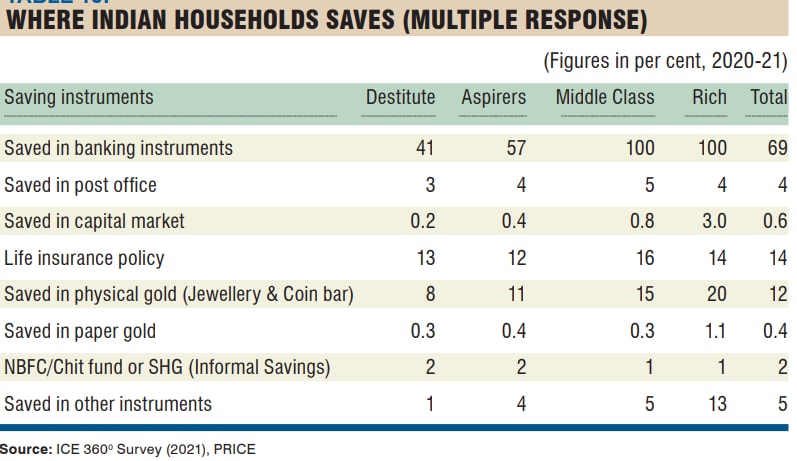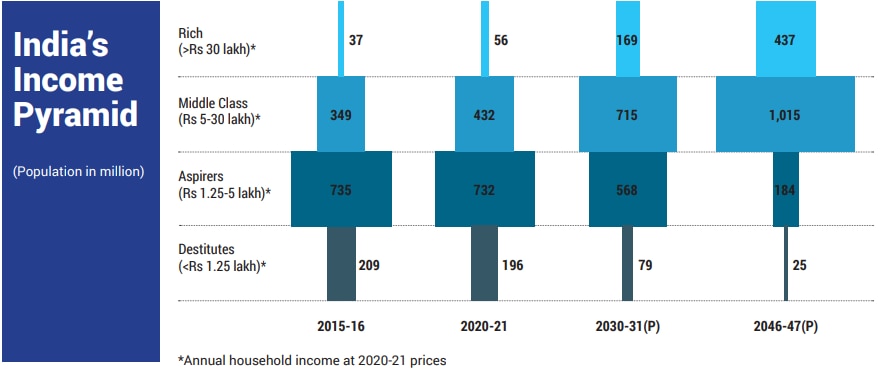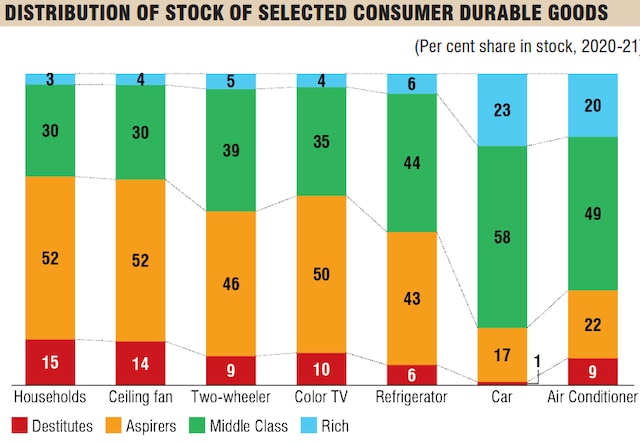3/4 of all Indian households are debt-free, 69% save in banking instruments
An overwhelming 69 per cent of all households in India have saved in banking instruments while barely 4 per cent of the country’s households save in post office, revealed a survey conducted by the People Research on India’s Consumer Economy (PRICE) an independent, not-for-profit think tank.
The survey covered over 40,000 households, both rural and urban from 25 states.

Digging deeper into the savings behaviour of households, the survey found that almost all Indian households have a savings bank account and 82 per cent have a bank account that is linked to an Aadhaar account.
Why are Indians saving?

PRICE defines a middle-class Indian as one earning between Rs 1.09 lakh and Rs 6.46 lakh per year in the 2020-21 prices, or Rs. 5 lakh to Rs. 30 lakh annually in household terms. The rich are categorised as those earning upwards of Rs 30 lakh annually, while the super rich are those with income of over Rs 2 crore in a year. The aspirer is those that fall in the income bracket of Rs 1.25-5 lakh a year, while destitutes are those that earn less than Rs 1.25 lakh in a year.
Middle class and rich households have a more diverse savings portfolio
While destitute and aspirer income groups hold most of their savings in bank accounts, a certain percentage of this is also being saved in gold and jewellery and informal saving. The Middle Class and Rich households are exposed to a more diverse savings portfolio with banking accounts, insurance policies and gold being among the top three options.
Saving in capital market instruments is primarily used by Rich households, revealed the survey.
Three-fourths of all Indian households are debt-free
Quantum of inherited debt is larger for rich households
The survey found inherited debt as also mortgaged assets are major concerns for the rich income households’ group. While 25 per cent of poorer households have at least some assets currently mortgaged, the figure is 44 per cent for the rich income households. Surprisingly, almost three times more rich households than poor have inherited debt.
High income households take formal loans to buy real estate
At an all-India level 38 per cent of formal borrowing is used to meet agricultural and livestock requirements. Nearly 40 per cent of formal loans that the rich households take are related to purchase of real estate compared to just 11 per cent for middle class households.
In contrast, the main reason for taking a formal loan among the Destitute groups is to meet agricultural and/or livestock requirements, followed by medical emergencies and meeting social obligations such as expenses for weddings, etc, revealed the PRICE study.
Low-income households take informal loans to meet medical emergencies
Ten per cent of all Indian households use informal loans to purchase land and 25 per cent of such loans go towards meeting medical emergencies and health related issues. Social obligations constitute 21 per cent of such loans, said the survey.
Long term indebtedness a major concern for low-income households.
At an all-India level, 44 per cent of formal borrowers and 45 per cent of informal borrowers claim they will be able to repay their loans within a one to-three-year period. Almost 19 per cent formal borrowers and 21 per cent informal borrowers respectively are not sure as to when they will become debt-free.

In India, the motorcycle is the symbol of an upwardly mobile Indian household. While the proportion of Destitute households that own a bicycle is significantly large (63 per cent), almost 34 per cent such households own a two-wheeler (moped or motorcycle or scooter). For Aspirer and Middle class households this percentage is 47 per cent and 70 per cent respectively.
Even among rich households, 75 per cent own a two-wheeler (mostly luxury motorbike) compared to 100 per cent who own a car.
An overwhelming 93 per cent of all Indian households today have mobile connections
The most dramatic change that is being witnessed across all households is in the digital infrastructure space. An overwhelming 93 per cent of all Indian households today have mobile connections, 64 per cent have dish or cable connections and 52 per cent have internet connections. Computer/laptop ownership is lower at 8 per cent.
 Loan, Personal Loan, Home Loan, Business Loan,Loans in India Loan in India, Personal Loan, Home Loan, Business Loan, Loans in India,Loan Finance,Loan in India, Get Instant Personal Loan,Home Loan, Business Loans in India
Loan, Personal Loan, Home Loan, Business Loan,Loans in India Loan in India, Personal Loan, Home Loan, Business Loan, Loans in India,Loan Finance,Loan in India, Get Instant Personal Loan,Home Loan, Business Loans in India